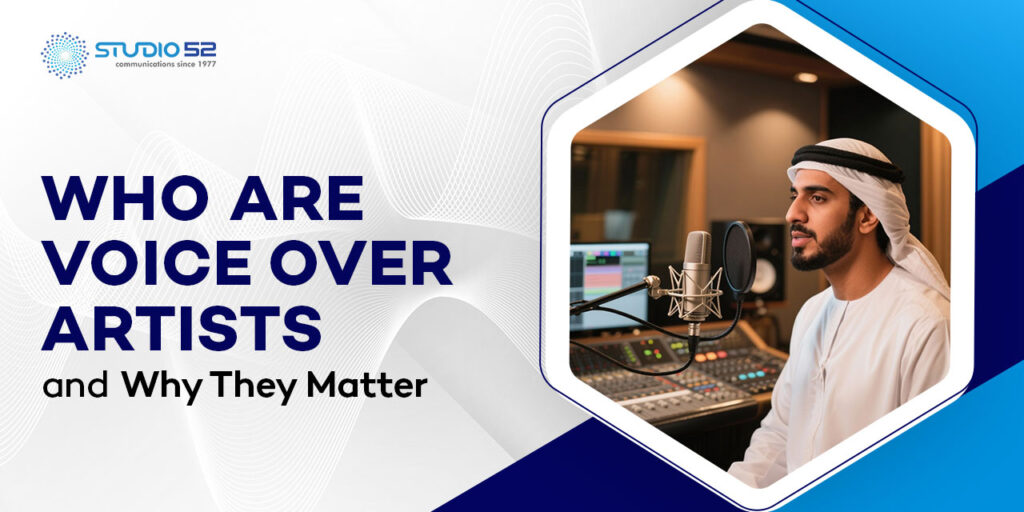You’ve heard them a thousand times, but you’ve probably never seen their faces. Right now, somewhere in the world, a voice artist is in a recording studio bringing a character to life for an animated film. Another is narrating an audiobook that thousands will listen to this week. A third is recording a commercial that will run during primetime TV.
Voice artists are the invisible storytellers of modern media. They shape how we experience entertainment, learn new information, and connect with brands. Yet most of us never think about the person behind the voice.
This guide pulls back the curtain on this fascinating profession. By the end, you’ll understand who voice artists are, what makes their work essential, and why supporting talented voice professionals matters for the quality of the content you consume.
Table of Content
What is a Voice Artist?
A voice-over artist is a professional whose instrument is their voice. They use it to convey emotion, tell stories, create characters, and communicate messages across audio platforms, from radio and podcasts to animated films, video games, and corporate training videos.
It sounds simple. It’s not.
Voice Artist vs. Voice Actor vs. Voice-Over Artist
These terms are often used interchangeably, and that’s actually fine. They’re essentially the same profession with slightly different emphases. A voice actor might focus on character work for animation. A voice-over artist might specialize in commercials and narration. A voice artist is the umbrella term covering all of it.
The distinction matters less than the skill: the ability to deliver a compelling performance using only your voice.
Types of Voice Artists and Their Specializations
Voice artistry isn’t one-size-fits-all. Different specialists bring different skills:
Commercial voice artists record ads for TV, radio, and online platforms. They’re energetic, persuasive, and masters at creating emotional connections in 30 seconds.
Narrators guide audiences through documentaries, audiobooks, and training videos. They need vocal endurance, clarity, and the ability to maintain engagement for hours.
Character Voice Actors bring animated characters to life in films, TV shows, and video games. This requires range, emotional depth, and the ability to differentiate multiple voices instantly.
Dubbing Artists adapt foreign films and shows for new markets. They match emotions, timing, and lip movements while bringing authenticity to another language.
IVR and telephony artists are the calm voices on phone systems, GPS devices, and virtual assistants. Precision, consistency, and neutrality are everything here.
Promo and Trailer Artists build anticipation through movie trailers and event announcements. They need dramatic delivery and the ability to create urgency.
Each specialization demands different skills, training, and experience.
The Skills That Make a Voice Artist
Technical Mastery
Professional voice artists understand microphone technique, breath control, and how to deliver consistent performances across multiple takes. They know how to read a script cold and make it sound conversational. They can nail complex pronunciations, master different accents, and maintain perfect timing.
These technical skills take years to develop and continuous practice to maintain.
Artistic Excellence
Beyond technical ability, great voice artists bring emotional intelligence. They analyze scripts, understand subtext, and deliver performances with genuine feeling. They can create distinct character voices and adapt their delivery based on direction. They’re storytellers, not just readers.
Business Acumen
Professional voice artists also manage their careers like small business owners. They understand contracts, negotiate rates, market themselves, maintain home studios, and manage client relationships. It’s as much about business as it is about performance.
Why Voice Artists Matter: Their Real Impact
Entertainment and Media
Voice artists make entertainment accessible and immersive. That beloved animated character? They’re not real. Their voice is. Voice actors create emotional connections that drive billion-dollar franchises. Dubbing artists make international content available to global audiences. Without them, entertainment would look completely different.
Marketing and Advertising
A great voice can sell products. Studies show that voice quality influences consumer behavior and brand perception. When you hear a voice in an ad and it feels trustworthy, professional, and aligned with the brand, that’s intentional. That’s a voice artist doing their job perfectly.
Education and Accessibility
Audiobooks, e-learning courses, and podcasts have exploded in popularity. Voice artists make learning more accessible, engaging, and inclusive for auditory learners and people with visual impairments. They’re not just performers, they’re accessibility champions.
Corporate Communications
Companies use voice artists for training videos, investor presentations, and customer service systems. A professional voice builds credibility and ensures consistent brand messaging across touchpoints.
The Journey: From Beginner to Pro
Starting a voice artistry career typically begins with discovering your strengths. Are you naturally persuasive? Do you have range? Can you take direction?
Next comes training. Many voice artists take classes, work with coaches, or pursue online certifications to develop professional technique. Building a demo reel, a sample of your best work, is essential to landing jobs.
Breaking into the industry means hustling: finding work through online platforms, talent agencies, or direct outreach. Most start part-time while building a portfolio. Those with talent, persistence, and business sense eventually transition to full-time careers.
Success stories vary widely. Some voice artists become household names through iconic character voices. Others build profitable careers in commercial or corporate work without ever becoming famous. Different paths, same respect for the craft.
The Economics: What Voice Artists Actually Earn
Voice artist compensation varies dramatically based on experience, specialization, and project type. Entry-level voice artists might earn $50-200 per finished hour. Experienced professionals working with major studios or on union projects can earn $500+ per hour.
Income depends on several factors: project scope, usage rights, geographic market, and whether the artist works union or non-union. Many voice artists build income from multiple streams, including commercial work, audiobooks, podcast narration, corporate videos, and direct clients.
The challenge? Platform saturation. Online marketplaces have made voice services more accessible to clients, which can compress rates in some markets.
Learn More: How Professional Voice Over Artists Enhance Your Business’s Image
Challenges in the Modern Era
Voice artists face real challenges. Market saturation means more competition. AI and synthetic voice technology are evolving rapidly, raising questions about the future of human voice work. Vocal health issues can threaten careers. Finding consistent, well-paying work is harder than it sounds.
But here’s the truth: AI can generate voices, but it can’t consistently deliver the emotional authenticity that humans bring. There’s something irreplaceable about a human voice that’s intentional, skilled, and emotionally intelligent.
The Future of Voice Artistry
The podcasting boom is creating unprecedented demand for narrators. Virtual reality, metaverse applications, and personalized content are opening new frontiers. Global content localization, dubbing and adaptation for different markets continues to grow.
Technology will evolve. Remote recording sessions are already standard. AI tools will assist (not replace) voice artists. But the need for authentic human voices isn’t going anywhere.
Appreciating the Craft
Next time you hear an exceptional voice performance, whether it’s a character you love, a podcast that captivates you, or a commercial that feels perfectly aligned with a brand, take a moment to appreciate the artist behind it.
Voice artists aren’t just reading words. They’re breathing life into stories, building brands, creating accessibility, and shaping how we experience media.
At Studio52, we work with exceptional voice artists across 20+ languages and dialects. We understand that great voice work is invisible until it’s absent. It’s the difference between content that resonates and content that’s forgotten.
Your brand deserves a voice that tells your story beautifully. Let’s find the right one together.
Frequently Asked Questions
How much does professional voice work cost?
Can I hire a voice artist for a one-time project?
What’s the difference between a voice actor and a voice artist?
How long does voice recording typically take?
Do I need to be in the studio with the voice artist?
Will AI replace voice artists?


